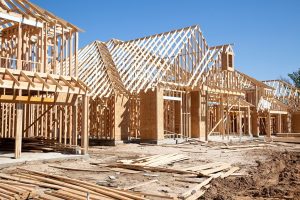Choosing the Building Site: The location of a building can affect its energy bills, comfort, and even long-term durability. For example, locating a building at the top of a hill might give you pretty views but will expose the building to stronger winds than locating the building at a lower elevation. A building site among tall trees may be a tranquil location but likely will prevent you from installing a solar energy system. Building next to a stream may be relaxing but can also be flooded easily.
Lot vs. Acreage vs. Infill: There are many choices available to locate a new residence and each one has pros and cons:
A lot in a subdivision can have amenities like a sidewalk or a nearby park or grocery store. Very often there are necessary utilities, such as water, electrical, and natural gas1 connections available. However, a lot can have neighbors who live close, dogs who bark, and other potential nuisances.
 An acreage can be very appealing since it offers space, the ability to grow crops and animals, and a certain feeling of independence. An acreage also be located far away from grocery stores, hospitals, schools, restaurants, entertainment, and other things that people like to do to get away from home.
An acreage can be very appealing since it offers space, the ability to grow crops and animals, and a certain feeling of independence. An acreage also be located far away from grocery stores, hospitals, schools, restaurants, entertainment, and other things that people like to do to get away from home.
Homes on acreages can also be without power for long periods, have poor or no Internet connectivity, and other negatives. On the plus side, acreages can offer great locations for solar systems, wind machines, outbuildings, farm equipment, and other bonuses.
Infill locations can be places where other homes used to exist or where items like ponds are filled with rock and dirt to become available as a building site. An infill location is not necessarily a bad location, but the term ‘infill’ can have a negative connotation to it. Most green programs give extra points or credits for building on an infill location.
 When determining a location for a new home or small commercial building the closeness or proximity to services can be important. Older people like to be near a hospital whereas younger people seek locations near bars, theaters, or similar entertainment venues. The location of the nearest bus stop can be important and being within the boundaries of a desired school can be very important to young parents.
When determining a location for a new home or small commercial building the closeness or proximity to services can be important. Older people like to be near a hospital whereas younger people seek locations near bars, theaters, or similar entertainment venues. The location of the nearest bus stop can be important and being within the boundaries of a desired school can be very important to young parents.
There are other site considerations as well, such as proximity to community services, zoning restrictions, natural features, solar access, and site preparation. As any Real Estate agent will tell you, what is on the site can always be changed but the location is permanent. Make sure you have taken all the considerations into account by working your way through the Green Building Decision Kit.
- Natural gas connections are not available in many locations There are other options such as: Propane gas, fuel oil, solar or wind energy, and other alternative energy sources.

